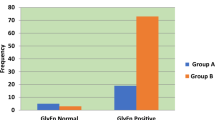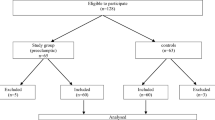Abstract
Plasma fibronectin (FN) levels in obese/overweight and non-obese pregnant women were evaluated as a possible risk factor for preeclampsia. A total of one hundred and sixty three pregnant women attending antenatal clinic at University of Calabar Teaching Hospital participated in the study and sixty non-pregnant women served as control. About 77 (47.24%) of the pregnant women were followed up for any subsequent development of preeclampsia during the pregnancy. Fibronectin levels in plasma were measured by ELISA assay and serum total protein, urea and creatinine were determined spectrophotometrically. The mean plasma FN concentration of non-obese pregnant women in first trimester was lower than those of the non-pregnant women by 24%, but however, increased to the non-pregnant level in second and third trimesters. Obese/overweight pregnant women had significantly (P < 0.05) higher values than non-obese pregnant women in second and third trimesters. FN in obese/overweight pregnant women correlated positively with mean arterial blood pressure (MAP: r = 0.414, P = 0.04). About 28.57% of the pregnant women with FN above cut off point of 330 μg/ml at 18–24 weeks of gestation developed preeclampsia. This value increased to 40.0% when only the obese/overweight women were considered. On analysis of both fibronectin >330 μg/ml and MAP > 90, the predictive value increased to 66.7%. We therefore conclude that elevated FN may be regarded as a risk factor of preeclampsia especially among the obese women.

Similar content being viewed by others
References
Santas AJ, Peterson JA, Halbleib JL, Craig SE, Humphries MJ, Peters MP. Alternative splicing of the III CS domain in fibronectin governs the role of the heparin II domain in fibrilogenesis and cell spreading. J Biol Chem. 2002;277(16):13650–8.
Mette N, Ozturk IH, Colpan L. Plasma fibronectin and urine glycosaminoglycan levels in rheumatic disease. Trop J Med Sci. 1998;28:437–41.
Kanters SDJ, Banga JD, Algra A, Frijins RCJM, Beutler JJ, Frijnheer R. Plasma levels of cellular fibronectin diabetes. Diabetes Care. 2001;24:323–7.
Man SFP, Xing L, Connett JE, Anthonisen NR, Wise RA, Tashkin DP, Zhang X, Vessey R, Walker TG, Celli BR, Sin DD. Circulation fibronectin to C-reactive protein ratio and mortality: a biomarker in COPD? Eur Respir J. 2008;32:1451–7.
Song KS, Kim HK, Shim W, Jee SH. Plasma fibronectin levels in ischemic heart disease. Atherosclerosis. 2001;154:449–53.
Waalkes S, Atschekzei F, Kramer MW, Hennenlotter J, Vetter G, Becker JU, Stenzl A, Merseburger AS, Schrader AJ, Kuczyk MA, Serth J. Fibronectin 1 mRNA expression correlates with advanced disease in renal cancer. BMC Cancer. 2010;10:503–9.
Warawdeker UM, Zingde SM, Iyer KS, Jgannath P, Mehta AR, Mehta NG. Elevated levels and fragmented nature of cellular fibronectin in the plasma of gastrointesyinal and head and neck cancer patients. Clin Chim Acta. 2006;372:83–93.
Orem C, Celik S, Orem A, Calapoglu M, Erdol C. Increased plasma fibronectin levels in patients with acute myocardial infarction complicated with left ventricular thrombus. Thromb Res. 2002;105:37–41.
Orem C, Durmus I, Kilinc K, Baykan M, Gokce M, Orem A, Topbas M. Plasma fibronectin level and its association with coronary artery disease and carotid intima-media thickness. Coron Artery Dis. 2003;14(3):219–24.
Peters JH, Loredo GA, Chen G, Maunder R, Hahn TI, Wilits NH, Hynes RO. Plasma levels of fibronectin bearing the alternatively spliced EIIIB segment are increased after major trauma. J Lab Clin Med. 2003;141:401–10.
Khong TY, de Wolf F, Robertson WB, Brosens I. Inadequate maternal vascular response to placentation in pregnancies complicated by preeclampsia and small for gestational age infants. Brit J Obstet Gynaecol. 1986;93:1049–59.
Das V, Bhargava T, Das SK, Pandey S. Microablbuminuria: a predictor of pregnancy induced hypertension. Brit J Obstet Gynecol. 1996;103:928–30.
Cedergren MI. Maternal morbidity, obesity and the risk of adverse pregnant coutcome. Obstet Gynecol. 2004;103:219–26.
Jensen DM, Darmm P, Sorensen B, Molsted-Pedersen L, Westergaard JG, Ovesen P, Beek-Nielsen H. Pregnancy outcome and prepregnancy body mass index in 2459 glucose tolelrent Danish women. Am J Obstet Gynecol. 2003;189(1):239–44.
Sebire NJ, Jolly M, Harris JP, Wadsworth J, Joffe M, Beard RW, Regan L, Robinson S. Maternal obesity and pregnancy outcome. A study of 287213 pregnancy in London. Int J Obstet Rel Metab Disorders. 2001;25(8):1175–82.
O’Brien TE, Ray JG, Cham WS. Maternal body mass index and the risk of preeclampsia: a systematic overview. Epidemiology. 2003;14:368.
Davi G, Guagnano MT, Ciabattoni G, Basilli S, Falco A, Marinopiccoli M, Nutini M, Sensi S, Patrono C. Platelet activation in obese women: role of inflammation and oxidative stress. JAMA. 2002;288(16):2008–14.
Wolf M, Kettyle E, Sandler L, Ecker JL, Roberts J, Thadhani R. Obesity and preeclampsia: the potential role of inflammation. Obstet Gynecol. 2001;98(5):757–62.
Ramsay JE, Ferrel WR, Crawford L, Wallace AM, Greer IA, Saltar N. Maternal obesity is associated with deregulation of metabolic, vascular and inflammatory pathways. J Clin Endocrinol Metab. 2002;87:4231–7.
Robertson WB, Khong TY, Brosens I, DeWolf F, Sheppard BL, Sonrlar J. The placental bed biopsy: review from three European centres. Am J Obstet Gynaecol. 1986;155:401–6.
Knottnerus JA, Van Weel C, Muris JWM. Evaluation of diagnostic procedures. BMJ. 2002;324:477–80.
Tomoda S, Tamura T, Sudo Y, Ogita S. Effects of obesity on pregnant women maternal hemodynamic changes. Am J Perinatol. 1996;13:73–8.
Strevens H, Kristensen K, Langhoff-Roos J, Wide-Swensson D. Blood pressure patterns through consecutive pregnancies are influenced by body mass index. Am J Obstet Gynaecol. 2002;187:1343–8.
Klein S, Wadden T, Sugerman HJ. AGA technical review on obesity. Gynaecology. 2002;123:882–7.
Kane AB, Kumar V. Environmental and nutritional pathology. In: Kumar V, Abbas AK, Facusto N, editors. Pathologic basis of disease. 7th ed. London: Saunder Company; 2004. p. 415–68.
Ostlund E, Hansson LO, Bremme K. Fribronectin is a marker for organ involvement and may reflect the severity of preeclampsia. Hyperten Pregnancy. 2001;20(1):79–87.
Chavarria ME, Lava–Gonzalez L, Gonzalez–Gleason A, Sojo I, Reyes A. Maternal plasma cellular fibronectin concentrations in normal and preeclamptic pregnancies: a longitudinal study for early prediction of preeclampsia. Am J Obstet Gynecol. 2002;187:595–601.
Panevia-Masin J, Zafironvska K, Bogdanoska S, Lozance L, Gerasimoveska B. Changes in plasma fibronectin levels in pregnancy induced hypertension. Acta Med Croat. 2002;54(45):157–60.
Ascarelli MH, Morrison JE. Use of fetal fibronectin in clinical practice. Obstet Gynecol Surv. 1997;1:1–5.
Lopez RL, Francies JA, Garite TJ, Dubyak JM. Fetal fibronectin detection as a predictor of preferm birth in actual clinical practice. Am J Obstet Gynecol. 2000;182(5):1103–6.
Innes KE, Wimsatt JH. Pregnancy-induced hypertension and insulin resistance evidence for connection. Acta Obstet Gynecol Scand. 1999;78:283–9.
Author information
Authors and Affiliations
Corresponding author
Rights and permissions
About this article
Cite this article
Ekaidem, I.S., Bolarin, D.M., Udoh, A.E. et al. Plasma Fibronectin Concentration in Obese/Overweight Pregnant Women: A Possible Risk Factor for Preeclampsia. Ind J Clin Biochem 26, 187–192 (2011). https://doi.org/10.1007/s12291-011-0127-1
Received:
Accepted:
Published:
Issue Date:
DOI: https://doi.org/10.1007/s12291-011-0127-1




